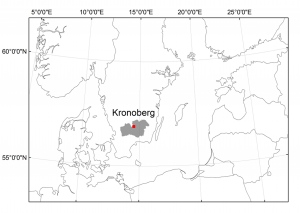
- North Karelia, Finland
- Kronoberg, Sweden
- Wales, UK
- South-East Veluwe, Netherlands
- Black Forest, Germany
- Montafon Valley, Austria
- Prades, Spain
- Chamusca, Portugal
- Panagyurishte, Bulgaria
- Carpathians, Romania
- European
|
Climate change challenge
Link to Case Study results here 
The Swedish case study area Kronoberg County is situated at the transition zone between the northern hemisphere boreal zone and the mid-Europe deciduous forest zone. Most of the forest consists of Norway spruce and Scots pine but also birch and other deciduous species are present. Kronoberg County was the most extensively damaged county in a major wind damage event on 8 January, 2005, when damage occurred on 14.1% of its forest acreage. Before 2005 the management of the risk of wind damage was not often adapted to the risk the individual forest owner was prepared to take.

Response to the challenge
A forest management programme aiming at a reduced risk of wind damage will be used in simulations of future states of the forest under climate and/or land use change. The changed management programme includes reduced length of the rotation period and use of deciduous tree species in regeneration at wind exposed locations. Adaptive feedback is acquired through evaluation of consecutive forest states with respect to the probability of wind damage. If a specified probability of wind damage is exceeded, this invokes additional risk-reducing changes in the management programme such as modification of the thinning regime. The effects of the programme aiming at a reduced wind damage risk will be evaluated with respect to yield, risk of wind damage, and the provision of recreation and forest owner life-style values, and will be compared to the currently recommended forest management programme.
Who will carry on the research and what models are applied
The probability of wind damage at landscape level will be calculated with the model WINDA-GALES. Using climate scenario data and a description of the state of the forest under climate change, the potential probability of wind damage under a changed climate can be assessed. The WINDA-GALES model will have extended functionality compared to the WINDA and GALES models, on which it is based. The descriptions of the state of the forest under climate change and under different forest management will be simulated using the model FTM.
This case study is lead by Swedish University of Agricultural Sciences and contact person is Kristina Blennow (kristina.blennow(at)ltj.slu.se).
Where the case study is situated, who owns the land
Kronoberg County is situated in southern Sweden. More than four fifths of the County is forested today. Seventy-nine percent of the productive forest land is owned by private forest owners. With few exceptions, the size of each land holding range from a few ha to a thousand ha. The forest provides a wide range of services to its owners as well as to the general public. The harvested forest provides raw material for the forestry industry and is used for timber, pulpwood and forest bio-fuel. The forest landscapes of Kronoberg County are important for recreation and activities such as berry and mushroom picking.
 Print view Print view
| 
